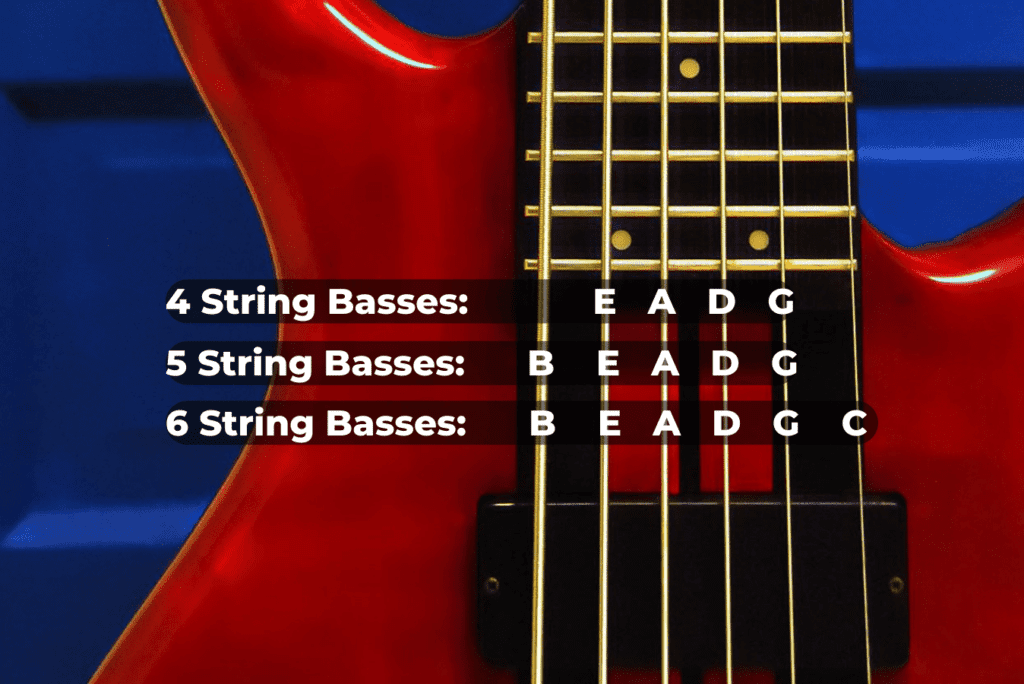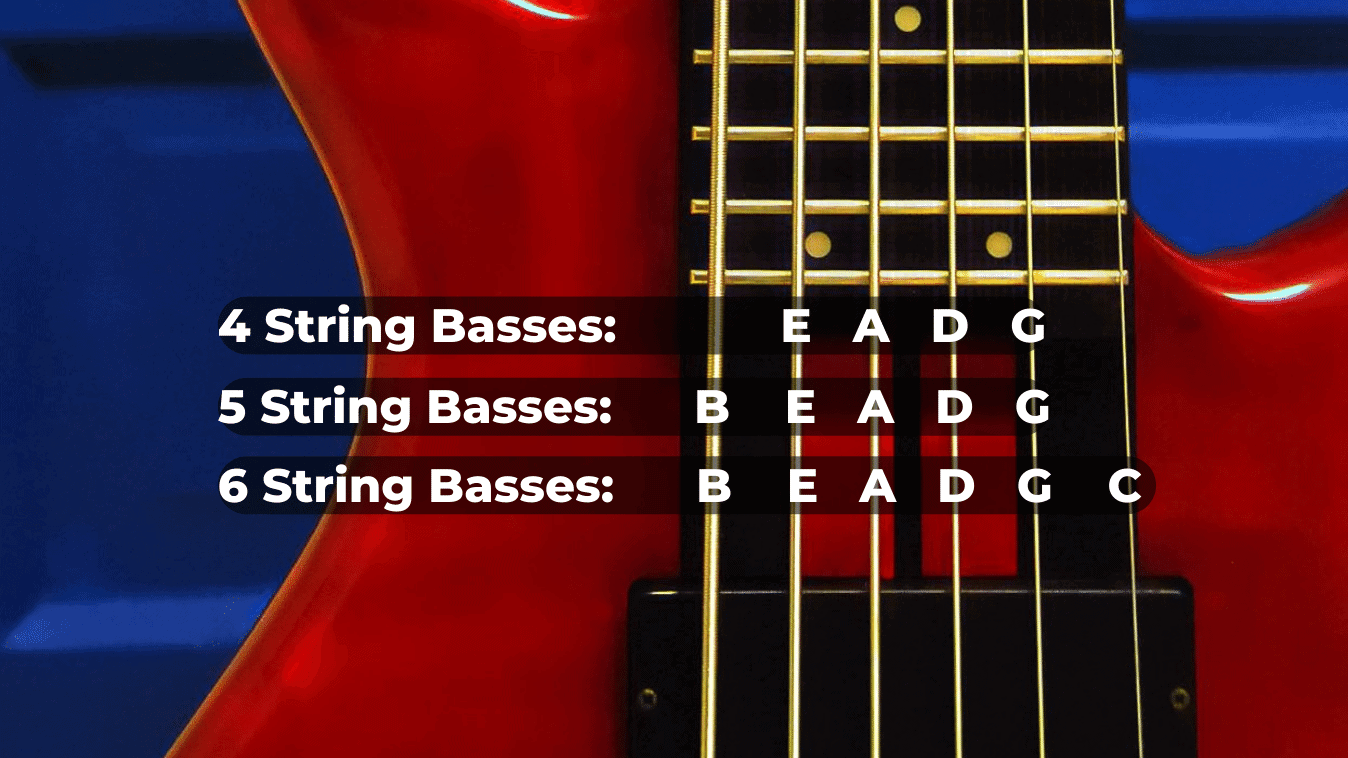Tuning often confuses new Bass players, even if they have a tuner. There are many ways to tune a Bass guitar and any of them is fine. Just as long as the result is your Bass being set to the desired tuning. Similar to tuning a guitar, a bass guitar can be tuned easily with a tuner. It can also be tuned by ear to itself, or by using a reference note from another source.
You should remember to tune your bass before every practice, and especially before recording. A well tuned bass guitar can make or break an entire song.
Table of Contents
Standard Bass Tuning
The standard tuning for a 4-string Bass is E-A-D-G. If your Bass is sitting in your lap, the thickest string (which should be the closest to you) is tuned to a low E. The next thickest string should be tuned to a higher A. The next to a higher D and the thinnest string (furthest away) to a higher G.
While these are typical tunings, they are not set in stone. You can tune your Bass in hundreds of different ways. But if you want to play covers or other people’s music, you’ll usually want to be in the standard tuning.

Here are three ways to tune your Bass without too much of a headache:
1. Use a Tuner
Plug your bass into your tuner just as you would into an amp. Turn the tuner on and make sure it’s set to “Bass” and “Auto”. Next, turn the volume knob on your Bass all the way up (clockwise turn). Now, starting with the lowest (lowest in tone = thickest) string, strike the string and observe the tuner. Allowing the note to ring, adjust the tuning key for that string (at the end of your Bass’s neck) until the tuner indicates a green light or “-0” tune on the appropriate note. For example, if you’re tuning a 4-string, the first string should be tuned to a low E. Once the tuner indicates that the string is right on the E note, move on to the next string. This way is, in fact, the exact way you’ll tune your guitar. This is the most accurate way for tuning a bass guitar.
2. Tune to yourself
Before self-tuning, you have to get an accurate note from somewhere. It could come from another instrument, a tuning fork, or from a digitally played song that has known notes. I would save the song thing as a last resort because of two reasons:
- It’s difficult
- It’s not always accurate
Generating An Accurate Source Note
Getting an accurate E is very important to tune your bass. E an accurate E and tune your E string to it. You’ll need to do this while the Bass is plugged into the amp. One thing that you’ll notice when audibly tuning to other instruments is that when your note is slightly different from the note you’re tuning to, the two notes ringing together will create a wavering or pulsating, ringing tone. This wavering effect indicates that the two tones don’t match. If you’re tuning your string in the wrong direction, the wavering effect will speed up. As you adjust your string and your tone gets closer to the tone of the source note, the wavering effect will slow down. As you tune your string closer and closer to the source note, the wavering will stop. When it stops, you are “in tune” with the source note.

Tuning The Rest Of The Notes
Now that you have one string in tune, it’s time to tune the rest. With an in-tune E string, we’ll move on and tune our A-string. Luckily, holding down the E-string on the 5th fret will provide us with an accurate A note. So, hold down the E string on the 5th fret, strike the E string letting the note ring, and immediately strike the A string letting that note ring as well. Turn the A string tuning key until the A string tone matches the E string 5th fret tone. Once it does, the A string will be tuned. Now, repeat this process on the A string 5th fret to tune the D string. And then the D string 5th fret to tune the G string.
This process can be used the same way for both 5 and 6 string Basses. Assuming they’re in the previously stated standard tunings. Don’t forget, the fat string should be tuned to a really low B.
This method isn’t the most accurate way to tune your bass, so it’s always good to check your string tones against each other (using octaves) or other instruments.
3. Harmonic Self-Tuning
This technique is almost identical to “Tune to yourself”. The only difference is the way we tune our bass’ strings to one another once we have an accurate note. Instead of using the 5th fret of the E string to find our A, we’ll use two harmonic E’s to tune the A string. Here’s how it works:
Producing Harmonics And Using Them To Tune Your Bass
Assuming the E-string is tuned, touch the E-string over the 12th fret. Don’t push the string down to the neck, just touch it directly over the fret. Then strike the E string (while your finger is still touching the string at the 12th fret). This should produce a ringing E note. This is a harmonic E note. Many people compare the harmonic tone to bells or chimes, so keep in mind that’s how they should sound. After you strike the harmonic E, you can move your left hand to the A string (7th fret) and the harmonic E should continue to ring. Immediately touch the A string above the 7th fret in the same manner and strike the A string with the right hand. This should create another harmonic E note that is identical in pitch to the one you just made on the E string.
Strike these notes again repeatedly and tune the A string to the E string while the notes ring. You’ll notice that the wavering effect is much easier to hear with harmonic notes. Making it easier to accurately tune the strings. This step is repeated on the 12th fret of the A string and the 7th fret of the D string. Then again on the 12th fret of the D string and the 7th fret of the G string.
Harmonics tones are a much clearer and more effective method of tuning Basses and Guitars. But electronic tuners are hands down the most accurate. I strongly suggest becoming proficient in harmonic tuning for those times when you don’t have a working tuner. But I also recommend buying an electronic tuner if you don’t already have one.
How to Tune a 5 String Bass?
A standard 5 string bass tuning, starting from low to high, is B-E-A-D-G.
The top 4 strings are tuned like a standard bass, and the additional string is tuned to B below the E note.
How to Tune a 6 String Bass?
6 string bass tuning is similar to 5 string, but this time, we add a higher string rather than a lower one. The notes, starting from low to high, are B-E-A-D-G-C.
In a 6 string bass, the 4 strings in the middle are tuned like a standard bass. The lowest string is tuned to B, and the highest string is tuned to C.

Conclusion
There you have it, and now you should be able to tune a bass guitar, in no time, without any issues. And you’re also familiar with 5 string bass tuning and 6 string bass tuning. Let me know in the comments if it helped you, or if you have another tuning method I didn’t add. See you next time!